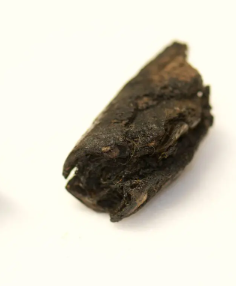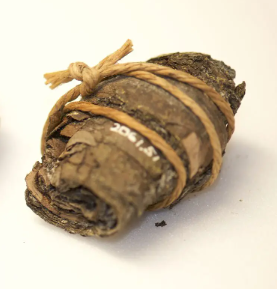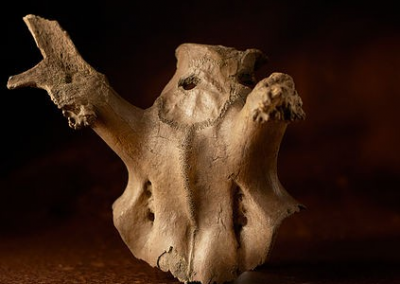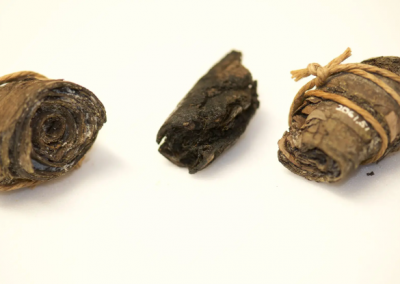Birch Bark Rolls from Star Carr
Rotunda Museum, Scarborough
A number of very special objects have been found in the archaeological site ‘Star Carr’, dating from the Middle Stone Age or Mesolithic period. The objects found there, including these rolls of bark gathered from birch trees 11,000 years ago, have helped archaeologists to understand the ways that people lived at that time.
Birch trees would have been an important source of natural materials. In total, 161 of these tightly-rolled strips of bark were found and had clearly been collected and probably stored. But why? Several theories have been put forward, including that they were used as floats for fishing nets, since the site is on the edge of a lake and fish would have been an important food source.
A highly flammable wood
However, if you look at some examples of the birch bark, you can see that they are charred. The flammable nature of birch has also led to theories that the bark would have been useful for lighting fires or perhaps for making torches.
Birch trees have a high level of resin which makes them particularly flammable. The bark is also very thin so is easier to ignite. Birch is known as a ‘pioneer’ species and was one of the first tree species to colonise the areas exposed by the retreating ice after the Ice Age.
hy is Star Carr such an important site?
As well as being flammable when dry, birch bark is also an ephemeral, natural material which would normally be expected to rot and disintegrate. Incredibly, it has survived for so many centuries to give us this glimpse into the lives of the people of the past. These objects were found buried in peat which had created anoxic conditions (without oxygen) so that the artefacts were preserved.
We’ll never know what the people who lived there called it, but the site of Star Carr marks a place where people seem to have built permanent houses and stayed there for extended periods of time. We sometimes talk of Star Carr as the site of the ‘oldest home in Britain’.
The people of the past
Star Carr has been known about since the late 1940s and a series of archaeological digs have provided a wealth of information. These birch bark remind us of the way that people’s basic needs have remained the same. We may think in different ways from prehistoric peoples or have different beliefs, but we still need warmth and food for survival.
You can find another object on the site from Star Carr. Explore unusual a ‘headdress’ or frontlet created from a red deer skull rolls and decide what it could have been used for.
Explore headdress
Look closely at the bark rolls. How old do you think they look?
Have you ever made a campfire or bonfire? What did you use for kindling? Did you find the fire easy or difficult to start?
Why would fires have been so important to Stone Age people? What uses would they have had for their fire?
Why would it have been important for Stone Age people to cook their food?
What do you make of the theory that these were used as floats for fishing nets? Does that seem plausible to you?
What challenges do you think face the museum staff who are caring for these objects?
Since being found, the bark rolls have been tied up with string. Why do you think this is?
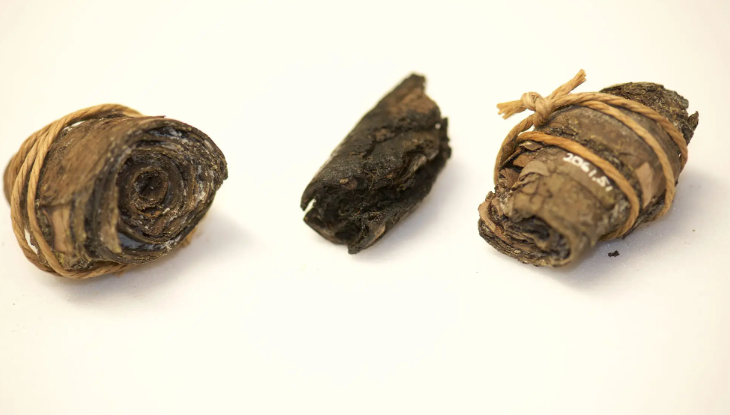
Vocabulary
Mesolithic: this term means the Middle Stone Age, usually referring to a period of hunter-gathers. The exact dates vary across Europe and the rest of the world. The site at Star Carr dates to around 9000 BCE
Flammable: easily set on fire
Ephemeral: lasting only a short period of time
Anoxic: without oxygen
In the Classroom
Hold a Debate
Discuss the students’ various ideas about what the birch bark rolls could have been used for. What evidence is there for each theory?
Introduce the debate motion: these birch bark rolls were used by Stone Age people to help them fish on Lake Flixton. Do any students agree? What are the counter arguments? Read tips to help you create formal debates.
Hands on History
The land has changed over time and today Star Carr is no longer visible. The site is just a private field and is not open to the public. However, amazing archaeological finds from Star Carr are exhibited at the Rotunda Museum, Scarborough.
Scarborough Museums and Galleries also run a Stone Age workshop including objects from Star Carr.
Museum Location
Explore more objects from the Stone Age on the site

